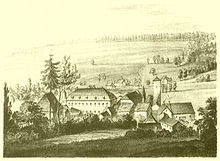Farnroda Castle
The Farnroda Castle was a castle and architectural monument built in 1677 in the municipality of Wutha-Farnroda in the Wartburg district and was located in the northern part of the historical location.
history
In the middle of the 15th century, the burgraves of Kirchberg acquired a new home in the Farnroda area through Sigmund von Kirchberg. Her previous goods were in the Saale valley near Jena . With the purchase of farms in Burbach , Seebach and Farnroda as well as meadows and arable land near Wutha and Eisenach , the Kirchbergers gained an economic basis for a new beginning in the Eisenach area. Around 1600 the traces of the Lords of Farnroda, who as local nobility (since the 13th century) were patron saints of the Laurentius Church and court lords of Farnroda, are lost. With the consent of the Duke of Eisenach, the Kirchbergers succeeded them and also took over the estate near the moated castle. As a sign of a new beginning, the old manor house was torn down and replaced by a half-timbered house built in the Renaissance style. At that time, the estate consisted of a four-sided courtyard with barns, stables and its own mill on the Erbstrom . To the north of the estate were the dilapidated remains of the medieval Farnroda moated castle and a pond.
On November 6, 1620, the main building of the castle and parts of the village burned down in a major fire. The former owner of the castle, Count Georg III. still had financial reserves to rebuild the castle. This was replaced by a new building in 1677 - it was a two-story stone building with a tiled mansard roof. The representative interior was decorated with rococo stucco and ornaments, while the exterior looked simple. Immediately at the castle (on today's Farnrodaer Hauptstrasse) in 1754 there were around 30 stately houses, 10 Hintersiedler houses, a shepherd's house, the inn and the syringe house.
The church of St. Laurentius and the associated parish were located along with other farms on Schönauer Weg. In 1799, the last Kirchberger entitled to inherit died, so all property of the Farnroda rulership fell as a settled fiefdom to the Duchy of Saxony-Eisenach. As a successor, the wealthy house in Sayn-Wittgenstein received the Farnrodaer property. At that time, the entire village of Farnroda consisted of 123 houses and farms, including the church of St. Laurentius and parish, the Princely Canzeley, a sheep farm in the Hucheroda farm, the upper and lower mill and a cutting mill. A copper mine was in operation on Ebertsberg with little success, the smelter located on the Erbstrom - now the district of Berlinchen - was supplied with ore from neighboring mining locations (Kittelsthal and Mosbach).
The next change of ownership took place in 1842: the Bause family appeared as buyers, selling the successful landowners around 1900 to Rittmeister Böninger, who preferred to make his fortune in the USA and moved there around 1915. In 1919 his relatives sold the estate and castle to the Hessian family Berthold Anzius, minus 200 hectares of agricultural land, which should be left to the landless farm workers and smallholders in the village of Farnroda for the establishment of part-time businesses. The Anzius family built up a horse breeding business on the estate, but during the Second World War all usable horses were soon confiscated by the military. After the end of the war, the rebuilding of the estate began for the landowning family, which was now in the Soviet occupation zone. In 1950 part of the stables at the castle burned down. The political pressure on the "large landowners" increased unexpectedly, part of the Anzius family fled to West Berlin , but Berthold Anzius did not leave Farnroda until 1958. In 1959 the estate was taken over by an LPG and the castle was designated as its administrative seat.
The demolition
Failure to carry out repairs to the roof resulted in dry rot in the roof structure and walls. Years later, the northern part of the building was blocked by the building authorities, and the roof collapsed in this area. The castle building became a ruin while tourists and spa guests were attracted and entertained in the neighboring castle park. The conditions were even denounced in the Eisenach regional press, some minor repairs and prohibition signs were the visible evidence of unsuccessful action. In the 1980s the southern part of the castle also had to be cleared. In the opinion of the authorities at the time, renovating the castle was never an option. After the political change, the Anzius family received their property in Farnroda returned. The ruinous castle could not be saved; it was demolished in 1997. In its place there is now a kindergarten and an apartment building.
literature
- Wolfgang Eberhardt: From the history of the Scharfenburg near Thal . In: On the history of the country on the Werra and Hörsel . (I). Verlag + Druckerei Löhr, Ruhla 1994, p. 45 . (History of the Lords of Farnroda)
- Wolfgang Eberhardt: The Farnroda rule from its beginnings to the sale to the Kirchbergers . In: Heimatblätter for the Eisenach district . Episodes 52-62. Eisenach 1995.
- HJ Saalfeld: A journey into the Erbstromtal. Part 4 (Wutha-Farnroda) . In: Hörselbergbote . Issue 11. DR-Werbeverlag, Wutha-Farnroda 1992.
- Manfred Beck: On the history of the Farnroda moated castle . In: Hörselbergbote . Issue 30. DR-Werbeverlag, Wutha-Farnroda 1997, p. 14-21 .
- Christa Reißig: Obituary (on a destroyed cultural monument) . In: Hörselbergbote . Issue 30. DR-Werbeverlag, Wutha-Farnroda 1997, p. 22-25 .
- Illustrated books Wutha-Farnroda Volumes I – IV . Geiger, Horb am Neckar 1991, 1992, 1997 and 2003, ISBN 3-89264-596-5 , ISBN 3-89264-706-2 , ISBN 3-89570-284-6 and ISBN 3-89570-859-3 .
Web links
Coordinates: 50 ° 56 ′ 29.4 ″ N , 10 ° 23 ′ 27.1 ″ E


